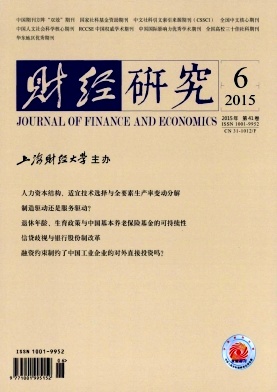高管薪酬、政治晋升激励与银行风险
财经研究 2015 年 第 41 卷第 06 期, 页码:
摘要
参考文献
摘要
国有控股银行的高管面临双重激励,他们不仅可以获得可观的薪酬,还有机会在政治上获得晋升。文章构建了衡量银行高管政治晋升激励的方法,并利用82家国有控股商业银行高管的个人数据,分析了高管双重激励与银行风险的关系以及两类激励之间的替代关系。实证结果表明,不管高管是董事长还是行长,薪酬的增加都会激励其更好地管理银行,降低银行的破产风险,但政治晋升激励对银行风险的负面影响仅对董事长成立。此外,薪酬激励与政治晋升激励之间存在替代关系,而且当前银行高管薪酬的平均水平非常接近实证分析得到的门槛值。因此,维持当前银行高管的薪酬水平而改进其薪酬结构是未来更为可行的方向,这为近期央企高管薪酬改革方案提供了理论依据。
[1]郝项超.商业银行所有权改革对贷款定价决策的影响研究[J].金融研究,2013,(4):43-56.
[2]蒋海,朱滔,李东辉.监管、多重代理与商业银行治理的最优激励契约设计[J].经济研究,2010,(4):40-53.
[3]林挺进.中国地级市市长职位升迁的经济逻辑分析[J].公共管理研究,2007,5:45-68.
[4]钱先航,曹廷求,李维安.晋升压力、官员任期与城市商业银行的贷款行为[J].经济研究,2011,(12):72-85.
[5]陶然,苏福兵,陆曦,等.经济增长能够带来晋升吗?——对晋升锦标竞赛理论的逻辑挑战与省级实证重估[J].管理世界,2010,(12):13-26.
[6]杨瑞龙,王元,聂辉华. “准官员”的晋升机制:来自中国央企的证据[J].管理世界,2013,(3):23-33.
[7]张杰.注资与国有银行改革:一个金融政治经济学的视角[J].经济研究,2004,(6):4-14.
[8]郑志刚,李东旭,许荣,等.国企高管的政治晋升与形象工程——基于N省A公司的案例研究[J].管理世界,2012,(10):146-156.
[9]周黎安.中国地方官员的晋升锦标赛模式研究[J].经济研究,2007,(7):36-50.
[10]Cao J, Lemmon M, Pan X,et al. Political promotion, CEO incentives, and the relationship between pay and performance[R]. Working Paper, 2014.
[11]Chen C R, Steiner T L, Whyte A M. Does stock optionbased executive compensation induce risktaking? An analysis of the banking industry[J]. Journal of Banking & Finance, 2006, 30(3): 915-945.
[12]Conyon M J, He L. Executive compensation and corporate governance in China[J]. Journal of Corporate Finance, 2011, 17(4):1158-1175.
[13]DeYoung R, Peng E Y, Yan M. Executive compensation and business policy choices at US commercial banks[J]. Journal of Financial and Quantitative Analysis, 2013, 48(1): 165-196.
[14]Fahlenbrach R, Stulz R M. Bank CEO incentives and the credit crisis[J]. Journal of Financial Economics, 2011, 99(1): 11-26.
[15]Hagendorff J, Vallascas F. CEO pay incentives and risktaking: Evidence from bank acquisitions[J]. Journal of Corporate Finance, 2011, 17(4): 1078-1095.
[16]Hao X, Shen C. Why do chairpersons and CEOs in Chinese banks work hard?[R]. Working Paper, 2014.
[17]Houston J F, James C. CEO compensation and bank risk:Is compensation in banking structured to promote risk taking?[J]. Journal of Monetary Economics, 1995, 36(2): 405-431.
[18]John, K, Litov L, Yeung B. Corporate governance and risktaking[J]. Journal of Finance, 2008, 63(4): 1679-1728.
[19]Kale J R, Reis E, Venkateswaran A. Rankorder tournaments and incentive alignment: The effect on firm performance[J]. Journal of Finance, 2009, 64(3): 1479-1512.
[20]Kato T, Long C. CEO turnover, firm performance, and enterprise reform in China: Evidence from micro data[J]. Journal of Comparative Economics, 2006, 34(4): 796-817.
[21]Kini O, Williams R. Tournament incentives, firm risk, and corporate policies[J]. Journal of Financial Economics, 2012,103(2):350-376.
[22]Laeven L, Levine R. Bank governance, regulation and risk taking[J]. Journal of Financial Economics, 2009, 93(2): 259-275.
[23]Lazear E P, Rosen S. Rankorder tournaments as optimum labor contracts[J]. Journal of Political Economy, 1981, 89(5): 841-864.
[24]Li H, Zhou L. Political turnover and economic performance:The incentive role of personnel control in China[J]. Journal of Public Economics, 2005, 89(9): 1743-1762.
[25]Liang Q, Xu P, Jiraporn P. Board characteristics and Chinese bank performance[J]. Journal of Banking & Finance, 2013, 37(8): 2953-2968.
[2]蒋海,朱滔,李东辉.监管、多重代理与商业银行治理的最优激励契约设计[J].经济研究,2010,(4):40-53.
[3]林挺进.中国地级市市长职位升迁的经济逻辑分析[J].公共管理研究,2007,5:45-68.
[4]钱先航,曹廷求,李维安.晋升压力、官员任期与城市商业银行的贷款行为[J].经济研究,2011,(12):72-85.
[5]陶然,苏福兵,陆曦,等.经济增长能够带来晋升吗?——对晋升锦标竞赛理论的逻辑挑战与省级实证重估[J].管理世界,2010,(12):13-26.
[6]杨瑞龙,王元,聂辉华. “准官员”的晋升机制:来自中国央企的证据[J].管理世界,2013,(3):23-33.
[7]张杰.注资与国有银行改革:一个金融政治经济学的视角[J].经济研究,2004,(6):4-14.
[8]郑志刚,李东旭,许荣,等.国企高管的政治晋升与形象工程——基于N省A公司的案例研究[J].管理世界,2012,(10):146-156.
[9]周黎安.中国地方官员的晋升锦标赛模式研究[J].经济研究,2007,(7):36-50.
[10]Cao J, Lemmon M, Pan X,et al. Political promotion, CEO incentives, and the relationship between pay and performance[R]. Working Paper, 2014.
[11]Chen C R, Steiner T L, Whyte A M. Does stock optionbased executive compensation induce risktaking? An analysis of the banking industry[J]. Journal of Banking & Finance, 2006, 30(3): 915-945.
[12]Conyon M J, He L. Executive compensation and corporate governance in China[J]. Journal of Corporate Finance, 2011, 17(4):1158-1175.
[13]DeYoung R, Peng E Y, Yan M. Executive compensation and business policy choices at US commercial banks[J]. Journal of Financial and Quantitative Analysis, 2013, 48(1): 165-196.
[14]Fahlenbrach R, Stulz R M. Bank CEO incentives and the credit crisis[J]. Journal of Financial Economics, 2011, 99(1): 11-26.
[15]Hagendorff J, Vallascas F. CEO pay incentives and risktaking: Evidence from bank acquisitions[J]. Journal of Corporate Finance, 2011, 17(4): 1078-1095.
[16]Hao X, Shen C. Why do chairpersons and CEOs in Chinese banks work hard?[R]. Working Paper, 2014.
[17]Houston J F, James C. CEO compensation and bank risk:Is compensation in banking structured to promote risk taking?[J]. Journal of Monetary Economics, 1995, 36(2): 405-431.
[18]John, K, Litov L, Yeung B. Corporate governance and risktaking[J]. Journal of Finance, 2008, 63(4): 1679-1728.
[19]Kale J R, Reis E, Venkateswaran A. Rankorder tournaments and incentive alignment: The effect on firm performance[J]. Journal of Finance, 2009, 64(3): 1479-1512.
[20]Kato T, Long C. CEO turnover, firm performance, and enterprise reform in China: Evidence from micro data[J]. Journal of Comparative Economics, 2006, 34(4): 796-817.
[21]Kini O, Williams R. Tournament incentives, firm risk, and corporate policies[J]. Journal of Financial Economics, 2012,103(2):350-376.
[22]Laeven L, Levine R. Bank governance, regulation and risk taking[J]. Journal of Financial Economics, 2009, 93(2): 259-275.
[23]Lazear E P, Rosen S. Rankorder tournaments as optimum labor contracts[J]. Journal of Political Economy, 1981, 89(5): 841-864.
[24]Li H, Zhou L. Political turnover and economic performance:The incentive role of personnel control in China[J]. Journal of Public Economics, 2005, 89(9): 1743-1762.
[25]Liang Q, Xu P, Jiraporn P. Board characteristics and Chinese bank performance[J]. Journal of Banking & Finance, 2013, 37(8): 2953-2968.
引用本文
郝项超. 高管薪酬、政治晋升激励与银行风险[J]. 财经研究, 2015, 41(6): 0.
导出参考文献,格式为:





 6551
6551  2574
2574

